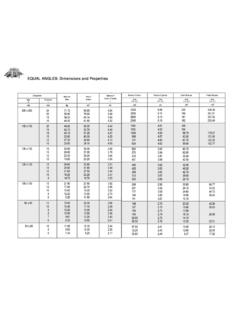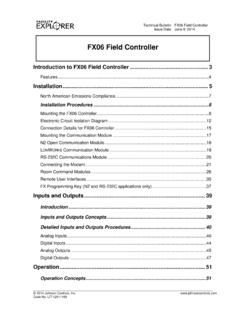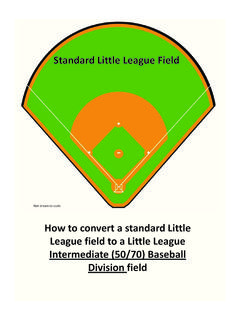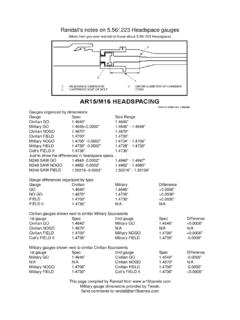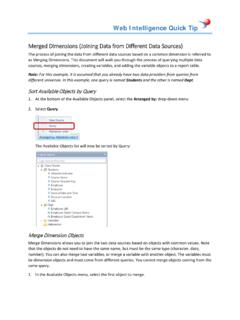Transcription of Dimensions and Types of Ethical Climate within Public ...
1 Shacklock, Manning & Hort Volume 9, Issue 1 (2011) JNBIT , (2011) 51 Journal of New Business Ideas & Trends 2011, 9(1), pp. 51-66. Dimensions and Types of Ethical Climate within Public Sector Human Resource Management Arthur Shacklock Griffith Business School Griffith University, Australia Email: Mark Manning Faculty of Business University of the Sunshine Coast, Australia Email: Linda Hort ANU College The Australian National University, Australia Email: Abstract Background In recent years there has been increasing emphasis on Ethical behaviour within Public sector jurisdictions. One approach to the description of the Ethical characteristics of workplace environments is that of Ethical Climate .
2 Purpose The purpose of the study is to identify the Dimensions relevant to Ethical Climate in Public sector human resource (HR) management. The study also identifies different Types of Ethical Climate profile and evaluates the degree to which these Types of Ethical environment can be seen to represent a moral continuum. Design/methodology/approach Questionnaires were returned from 255 Public sector HR practitioners. Principal components analysis identified Climate Dimensions and guided scale development. Cluster analysis identified different Types of Ethical Climate within the sample. Findings Five Ethical Climate Dimensions were identified and 5 scales developed: Law and rules ( = .83); Caring ( =.)
3 84); Independence ( = .73); Instrumental ( = .64); and Efficiency ( = .66). Five Types of Ethical Climate environment were also identified. Analysis of differences between these five Types of Ethical environment displayed a complex pattern of differences in cluster profiles. Conclusions The findings of this study support the notion that different Types of organisation will display different sets of Ethical Climate Dimensions . Analysis of differences between different Types of Climate environment failed to support the notion that Ethical environments lie along a simple uni-dimensional moral continuum. The study was limited to three Public service jurisdictions within a single country. Expanding beyond these limitations would increase generalisability.
4 Key words: Ethical Climate ; Public sector; human resource management; Ethical Climate questionnaire. Shacklock, Manning & Hort Volume 9, Issue 1 (2011) JNBIT , (2011) 52 Introduction In recent years Ethical behaviour and actions attempting to ensure good Ethical behaviour have been the focus of considerable attention within different jurisdictions of the Australian Public Sector (Shacklock 2006). One way to conceptualise the Ethical nature of a workplace arises from Lewin s (1975) Field Theory. Field Theory proposes a person s behaviour to be a function of their psychological field. In business research the psychological field has been empirically operationalised as organisational Climate (Jones & James 1979; Manning 2010), and in ethics research it has been defined more specifically as Ethical Climate (Victor & Cullen 1987; Tseng & Fan 2011).
5 This study uses the Ethical Climate Questionnaire (ECQ) of Victor and Cullen (1987) to, first, identify the Ethical Climate Dimensions relevant to 255 Public sector HR practitioners, and, second, identify the different Types of Ethical environment within which these HR practitioners operate. This study makes several contributions. First, several researchers propose different Climate Dimensions will be relevant in different industries and in different Types of organisation. The study examines Ethical Climate Dimensions in Public sector HR and contrasts the Dimensions found with those found elsewhere in organisations in the private sector. Second, the issue of different Types of Ethical environment has been confusing in the literature as several researchers have confused the quite distinct concepts of (a) Ethical Climate Dimensions , and (b) Types of Ethical environment.
6 At times, this has resulted from the use of inappropriate statistical analysis of data. This study uses an appropriate statistical technique to identify different Ethical Climate environments within the sample. Third, several researchers have explicitly proposed, or implicitly assumed, that Ethical environments can be considered to lie along a single moral continuum from unethical to Ethical . This study examines this proposal and compares similarities and differences between Types of Ethical environment identified. The results fail to support the proposal. Literature review In his Field Theory, Lewin (1975) proposed the behaviour of an individual to be a function of the psychological field subjectively experienced by them.
7 From Field Theory, it was not necessary to understand or investigate past events as concurrent measurement of the psychological field was all that was necessary. within the workplace, operationalisation of the psychological field comprises identification of the set of features of the social environment affecting employees behaviour and decision making. This has been labelled organisational Climate . Organisational Climate Moran and Volkwein (1992) describe organisational Climate as an enduring feature which embodies employee collective perceptions of factors including innovation, autonomy, support, cohesiveness, trust, recognition, and fairness. They view organisational Climate as being produced by member interaction, influencing and shaping behaviour, and as providing a basis for the interpretation of situational norms, values and attitudes of the organisation.
8 Commonly the approach used to measure organisational Climate is to record perceptions of individuals within the workplace to a number of items, factor analyse the responses (usually by using Principal Components Analysis, PCA) to identify underlying Dimensions and then, for each individual, to average across items loading on each of the Dimensions so derived (Jones & James 1979; Manning 2010). This procedure provides a score on each of the organisational Climate Dimensions , for each individual within that environment. For a particular organisation (or functional subunit) Climate values on each of Shacklock, Manning & Hort Volume 9, Issue 1 (2011) JNBIT , (2011) 53 the Dimensions are then simply estimated by aggregating the scores (usually by taking the arithmetic mean) of the individuals within the organisation.
9 The scales of organisational Climate thus far presented vary in terms of the number of Dimensions , the nomenclature of Dimensions and their psychometric properties. Schneider, for example states that ..what does seem to be clear is that Dimensions of practices and procedures will be differentially relevant depending upon the purpose of the study (1975, ). From a review of early Climate studies Schneider (1975) observed that often some dependent variable had implicitly driven Climate research. He later wrote Organisations may have many climates, including a Climate for creativity, for leadership, for safety, for achievement, and/or for service. Any one research effort probably can not focus on all of these but the effort should be clear about its focus (Schneider, Parkington & Buxton 1980, p.)
10 255). Over time, most Climate research concentrated on the measurement of a specific facet of the psychological field that was associated with the dependent variable driving the research. For example, Zohar (2000) examined Climate for safety; Delbecq & Mills (1985) examined Climate for innovation; and Schneider, White, and Paul (1998) examined Climate for service. Measuring Ethical Climate and its Dimensions The domain of organisational Climate investigated in this study is that related to Ethical decision making and has been labelled Ethical Climate . Victor and Cullen (1987; 1988) presented an attempt to identify the Dimensions of Ethical Climate in organisations using an approach with a similar philosophy to that presented earlier by Jones and James (1979) in their study of organisational Climate .


